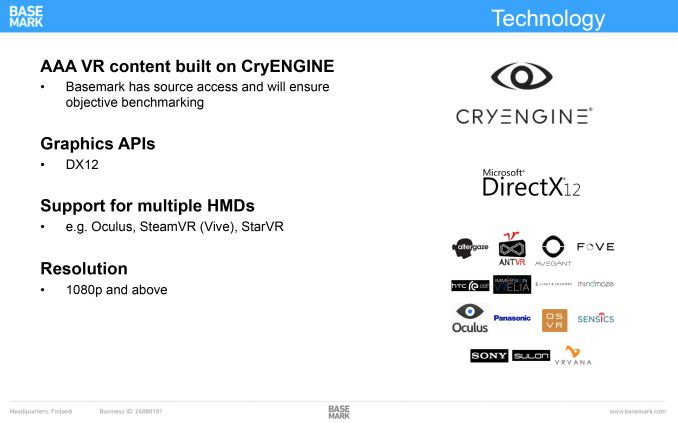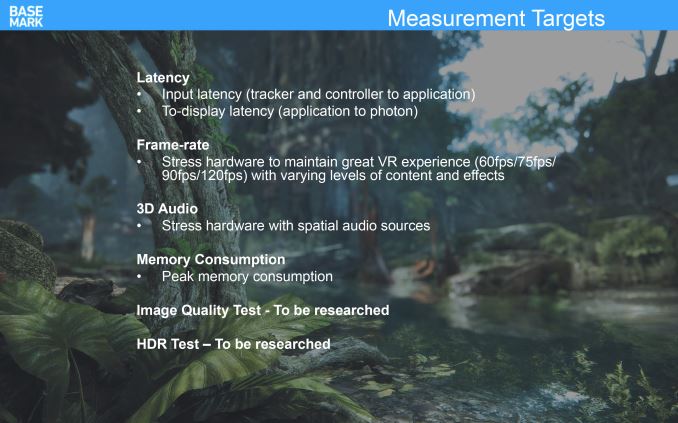Basemark & Crytek To Develop New VR Benchmark
by Ryan Smith on August 6, 2015 8:00 AM EST- Posted in
- VR
- BaseMark
- GPUs
- Benchmarks

After a very public development process over the last couple of years, this year we have seen the consumer release of virtual reality headsets become a matter of when, not if. The launch of the first generation of consumer VR headsets is now just a quarter away, and as software and hardware developers move out of the experimentation phase and into the production phase, we are seeing the complete VR ecosystem take shape. The hardware is coming along, the games are in development, and now the first benchmarks are being announced.
This morning benchmark developer Basemark and game engine developer Crytek are announcing that the two of them are partnering together to develop a new dedicated VR benchmark. In a presentation aptly named “Can it Run VR?” Basemark and Crytek have laid out their goals for the benchmark, which will be built around Crytek’s CRYENGINE. The two companies will be developing a full AAA quality VR benchmark for PCs running on top of DirectX 12, with the end product to be a “real-world” benchmark thanks to its use of a commercial game engine. Crytek for their part are no strangers to VR, with CRYENGINE already powering the Back to Dinosaur Island VR Tech demo.
For their benchmark, Basemark and Crytek are looking to evaluate several aspects of VR. Along with the expected look at framerates – Oculus has been pushing 90Hz – Basemark has also stated that the VR benchmark will have the capability to measure latency, both for inputs and displays. Latency has been a big focus point for the first generation headsets due to the fact that it is so crucial in causing/combating motion sickness, so the fact that the benchmark will incorporate testing for it may very well be the most important feature of this benchmark. Having a neutral 3rd party provide a standardized latency test will go a long way towards not just comparing headsets, but helping manufacturers improve them as well. Meanwhile, Basemark and Crytek have also mentioned that they will be looking at additional tests further down the line, including headset image quality and dynamic range.
Finally, while the benchmark is being announced today, the nature of the announcement makes us believe that the benchmark is still in early development. As part of their press release Basemark is including a call to action, inviting interested companies to sign up and participate in the development of the benchmark. As a result no firm date is attached to the project right now, but it’s a safe bet that this is going to be a 2016 release.
Source: Basemark


















8 Comments
View All Comments
edzieba - Thursday, August 6, 2015 - link
Cryengine seems a very odd choice for a VR benchmark. Cryengine has been left WELL in the dust by Unreal and Unity when it comes to VR support. Both have official support for both the Oculus Rift and HTC Vive, but thus far the only game using Cryengine with VR is Star Citizen; and that's a highly customised Cryengine variant whose VR support is at this stage only a technicality (the implementation is old and was unacceptably poorly performing back then).nathanddrews - Thursday, August 6, 2015 - link
I know that 90fps is regarded as a minimum target (ideal target) for immersion/persistence, and ideally it would be a constant 90fps locked to the refresh of the headset, but has there been any rumbling about utilizing Adaptive Sync (or G-Sync or FreeSync) for VR? If they (Oculus, Sony, Samsung, HTC, Valve, etc.) have looked into it, is there any documentation I could read? I'm guessing a constant frame rate is preferred to a fluctuating one, but since OLED displays are capable of ridiculous refresh speeds and computers are still struggling with 4K, let alone dual 1080p90 ultra streams for VR, it seems like a logical course of action. I know that John Carmack and Michael Abrash have both talked about frame rates and refresh rates around 1,000 being the "end game".edzieba - Thursday, August 6, 2015 - link
"has there been any rumbling about utilizing Adaptive Sync (or G-Sync or FreeSync) for VR?"Yes. It is incompatible with low persistance display driving.
By varying the time between display updates, you vary the time between display illumination periods. This varies the perceived brightness of the display: Not Good. Worse, in order to adaptively vary the brightness of each display 'pulse' in order to maintain a perceptually steady brightness, you'd need to predict IN ADVANCE what times the next few frames will be delivered. And because VR relies on as little latency as possible, you can't just buffer frames before delivery.
nathanddrews - Thursday, August 6, 2015 - link
Then wouldn't that justify a system like G-Sync to duplicate minimum frames (double/triple/etc.) to a higher refresh rate to maintain that persistence (45fps doubled to 90Hz, 30fps tripled to 90Hz)? I'm only referring to non-ideal situations where you can't maintain a perfect 90fps - what workaround do they have to mitigate these situations?Or are they just approaching this from the perspective of "if you can't have a perfect 90fps, then don't use VR"?
zepi - Thursday, August 6, 2015 - link
VR systems actually something like this in development.If a new frame doesn't arrive in time to be displayed on the next display out (fixed framerate) it is possible to use the framebuffer of last frame, run the head positioning correction again using that old frame and send that to the screen. This way at least head motion doesn't stop, even though world doesn't move around you and can seem jerky.
edzieba - Thursday, August 6, 2015 - link
"what workaround do they have to mitigate these situations?"Asynchronous TimeWarp - synthesising frames from the previous frame + the latest update from the IMU (+ fused position tracking). Previous timewarp implementations only updated the rotation matrix (slide the previous image across the view pre-warp), but the latest Rift SDK releases have added positional timewarp using the depth buffer to synthesise pixels for displaced edges.
nathanddrews - Thursday, August 6, 2015 - link
Interesting, I can't wait to see it in action. Thanks!jkostans - Thursday, August 6, 2015 - link
You can see it right now: http://www.gfycat.com/Whalefreezer/oculus_060